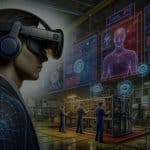Mixed reality (MR) technology is revolutionizing many fields, particularly the way remote expert assistance is delivered. This innovative technology merges both real and virtual worlds to produce new environments and visualizations where physical and digital objects coexist and interact in real time. It’s an immersive experience that transforms the user interface into a digitally enhanced, interactive environment. This article will delve into the impact of mixed reality on remote expert assistance and how it is reshaping the user experience.
Understanding Mixed Reality Technology
Before exploring the impact of mixed reality in the field of remote expert assistance, it is important to understand what this technology entails. In essence, mixed reality is a blend of physical reality and virtual reality, encompassing both augmented reality and virtual reality. It not only overlays but anchors virtual objects to the real world, enabling users to interact with the combined environment in real time.
Have you seen this : What Role Does AI Play in Detecting and Blocking Phishing Attacks?
Mixed reality is the next evolution in the immersive technology field. It allows users to see the real world, much like in augmented reality, but also overlays virtual content that users can interact with and manipulate, similar to virtual reality. This blend of real and digital enhances the overall user experience.
Moreover, mixed reality can be experienced with immersive technology devices such as headsets, glasses, or through applications on mobile devices. It’s this adaptability that makes mixed reality a versatile tool for numerous applications, especially in remote expert assistance.
Additional reading : What’s the Impact of AI in Streamlining E-Commerce Fulfillment and Logistics?
The Innovative Experience of Mixed Reality in Remote Expert Assistance
Remote expert assistance is a field that can greatly benefit from mixed reality technology. Traditionally, if a piece of machinery broke down or a technical issue arose, a specialist would need to be physically present to diagnose and rectify the problem. Now, mixed reality is transforming this model, enabling remote experts to provide real-time guidance without having to be on-site.
Through a mixed reality platform, a technician can share his or her point of view with a remote expert. The expert can then draw, annotate, and insert 3D models into the technician’s field of view to guide them through a process or task. This interactive, immersive experience allows technicians to resolve issues much faster than they would have done previously. The expert can also provide real-time knowledge transfer, fostering a learning environment that empowers the technician to handle similar situations in the future.
Revolutionizing Business Operations through Mixed Reality
Mixed reality technology is revolutionizing business operations by offering remote expert assistance in a variety of sectors like manufacturing, healthcare, and automotive. For instance, if a complex machine on a production line malfunctions, a technician wearing a mixed-reality headset can initiate a video call with a remote expert. The expert can see what the technician is looking at in real-time, annotate the technician’s view with instructions, and guide them through the repair process without having to travel to the site.
The application of mixed reality is not limited to machine repair. In healthcare, surgeons could use mixed reality to overlay patient scans onto their body, providing real-time, 3D visualizations to guide surgical procedures. Similarly, automotive designers could use it to create and manipulate 3D models of car parts. The ability of mixed reality to blend the physical and digital worlds is streamlining complex tasks, making them more efficient and less prone to errors.
The Future of Mixed Reality in Remote Expert Assistance
The future of mixed reality in remote expert assistance appears to be promising. Its ability to provide a blend of real and virtual content in an interactive, immersive environment is a game-changer in many industries. As the technology continues to advance, we can expect even greater capabilities and more innovative applications.
Areas like education, training, and learning will benefit significantly. Mixed reality can provide real-time, immersive learning experiences that are not possible with traditional methods. Students can interact with 3D representations of historical artifacts, or medical students can practice surgical procedures in a risk-free virtual environment.
Moreover, as mixed reality devices become more affordable and accessible, the technology may soon become a standard tool for remote expert assistance. As such, businesses will need to adapt and prepare for a future where mixed reality is part of the standard operating procedure. The transformative potential of mixed reality is immense – it stands to revolutionize not just remote expert assistance, but our interaction with the digital world at large.
As we have seen, mixed reality technology is already changing the game in remote expert assistance, and with continuous technology advancements, its impact will only continue to grow. This powerful tool that merges reality with the virtual world is shaping the future of user interaction and revolutionizing the way expert knowledge is shared and implemented. Even though the technology is still evolving, its potential is undeniable – mixed reality technology is undoubtedly the future of remote expert assistance.
Enhancing Customer Service with Mixed Reality Technology
One of the key areas where the application of mixed reality technology has shown incredible promise is in the enhancement of customer service. Organizations across different sectors are leveraging this groundbreaking tech to provide superior remote assistance to their customers.
The added benefit of real-time visual guidance through a mixed reality platform drastically improves the efficiency of customer service. For instance, if a user is facing a technical issue with a product, the service representative could use a mixed reality device such as the Microsoft HoloLens to view the customer’s real-life environment and guide them through the troubleshooting process. This real-time interaction allows the customer to rectify the issue quickly, reducing downtime and boosting customer satisfaction.
Moreover, remote field technicians can also use mixed reality technology to provide remote support during complex installations or maintenance activities. With the ability to overlay 3D models and provide real-time guidance, the technicians can handle even the most complicated tasks with ease, thereby further improving customer service.
In logistics and supply chain management, mixed reality technology can be used to track and manage goods efficiently. For example, a logistic manager could use a mixed reality application on his mobile device to virtually interact with the goods in the warehouse, thus streamlining the supply chain process.
Conclusion: The Transformative Impact of Mixed Reality on Remote Expert Assistance
The impact of mixed reality on remote expert assistance has been nothing short of transformative. It has revolutionized the traditional methods and introduced an interactive, immersive experience that is far more efficient and effective.
The combination of augmented reality and virtual reality provides a unique platform where the physical and digital worlds merge, creating a virtual environment that enhances real-time interactions. The ability to deliver expert knowledge and guidance remotely has not only streamlined business operations but also improved customer service significantly.
As the technology continues to evolve, the potential applications of mixed reality are boundless. From education and healthcare to manufacturing and logistics, every sector stands to benefit from the integration of mixed reality into their operations.
Adapting to a future where mixed reality is part of the standard operating procedure will require businesses to be open to change and ready to embrace this groundbreaking technology. As we move forward, we will continue to witness the transforming power of mixed reality and its indelible impact on remote expert assistance. The game is indeed changing, and it’s clear that mixed reality technology is leading the charge.











